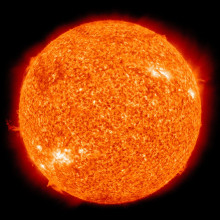Running a marathon, or just staying in a sauna? Rebecca Rendell tells us what that might be doing to you...
In this episode

Naked Body: Beating the heat
Rebecca Rendell, Bournemouth University
Running a marathon, or just staying in a sauna? Rebecca Rendell tells us what that might be doing to you...
In Mexico in 2016, during the last few hundred metres of the ITU World Triathlon Series, British athlete and Olympic medallist Jonny Brownlee had to be launched over the finish line by his brother, Alistair, because he was so hot he could not function properly.
Well, you might not have gotten that hot, but you probably do know what it feels like to be a bit hot and sweaty, and might have noticed things can be a bit harder.
Fortunately, we have behavioural and physiological mechanisms to cope with getting hot so that our bodies maintain a tightly-controlled internal environment and keep our normal functions going, whatever the weather.
But, anyone can get heat illness and it varies in severity – and is probably more important than losing a few minutes in a race.
It begins with muscles cramps, thirst, profuse sweating and fatigue. These symptoms can lead to heat exhaustion when the body becomes weak and the skin becomes pale and cool.
If left untreated, this can progress into heatstroke. Sweating ceases and you experience nausea, headaches, goose bumps and dizziness as blood pressure drops. The lack of sweat means you get hotter, because sweating is your body’s way of lowering temperature, as the sweat on your skin evaporates; it pulls heat from your body with it.
This lack of sweating also causes your metabolic rate to increase as your core temperature spirals out of control.
The pulse becomes rapid and the skin is hot and dry, and you could become confused. Proteins in the body break up and fluid can build up in the brain.
If left untreated, a person could experience seizures, coma or even death.
In the earlier stages of heat illness, people should stop exercising; take on fluid and electrolytes lost in sweat and find ways to cool down, for example, seeking shade, fanning, water sprays, ice vests or ice slurries. Which are all pleasant things to do normally!
Our blood carries the heat around our body, to improve the heat loss from the skin surface, you want more blood to be closer to your skin’s surface.
To achieve this, your blood vessels get wider – called vasodilatation, You can visibly see the effects of this, particularly the bulging veins in your hands, forearms and feet.
Of course, if your blood is busy trying to get rid of the heat by travelling to your skin, you will have less available to the muscles for exercise (this is important because blood also carries oxygen to do work) and this can negatively impact performance.
Studies have shown the optimal outside temperature for endurance performance is around 11°C. So how do some people perform exceptional feats of endurance in the heat.
Well, as well as the acute responses to deal with the heat, our body can also adapt to the heat so it isn’t as stressful next time we encounter it – called heat acclimatisation. The amount you sweat can more than double, which helps you to deal with higher temperatures.
In summary, environmental factors, like heat, should be considered seriously since they can lead to illness but can also be used as tools for training to improve exercise or occupational performance and health.
Related Content
- Previous Why won't water burn?
- Next Reflecting on Voting










Comments
Add a comment